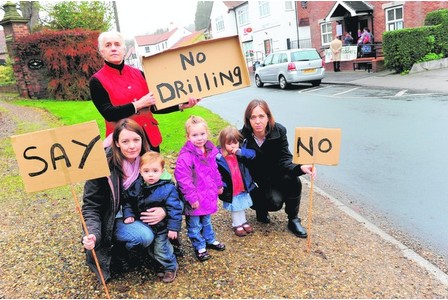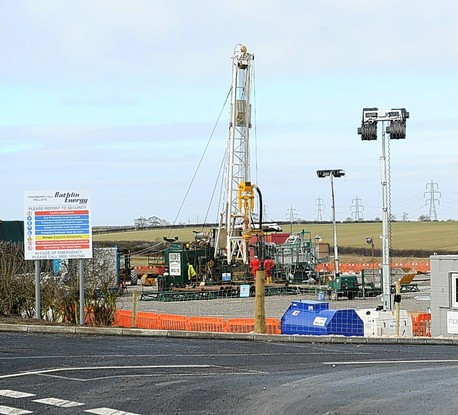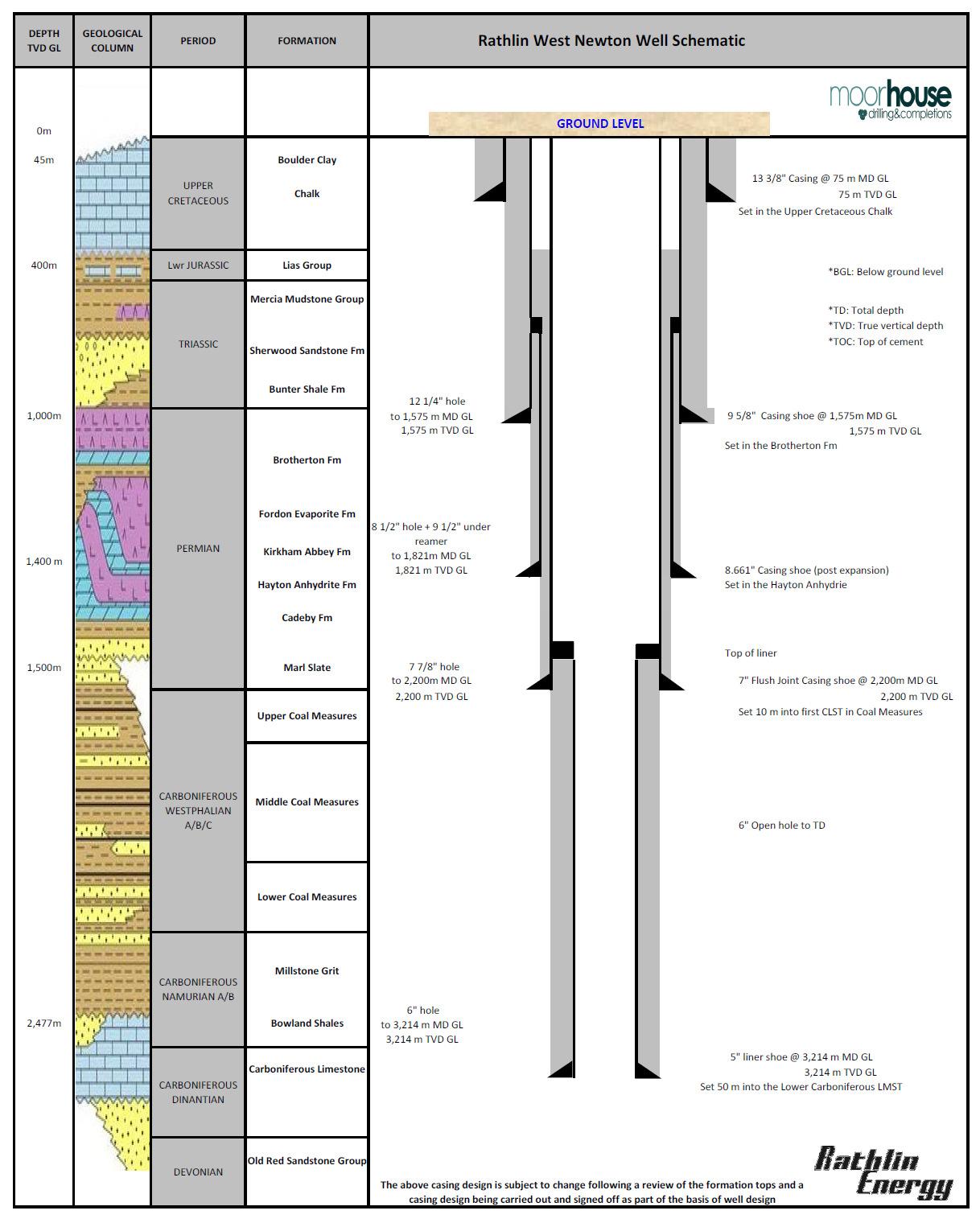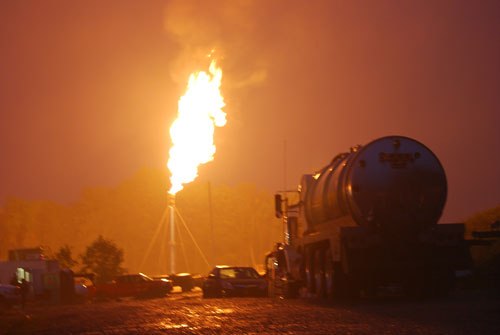Summary
- Rathlin Energy have licence in East Yorkshire
- Openly exploring for conventional oil and gas
- Sneakily drilled 2 wells through Bowland Shale
- Now planning small test fracks on shale layer
- Producing 100,000 gallons of radioactive waste
- No information on where this would be dumped
- Would flare 5 million cubic feet of gas per day
- Producing toxic and carcinogenic air pollutants
- Aims to gather data for full hydraulic fracturing
- Could mean up to 3,000 wells in the licence
- Application for similar well in Northern Ireland

Residents Of Walkington, East Yorkshire Who Opposed Rathlin Energy’s Original Planning Application For The Crawberry Hill Drilling Site In 2011 (Click To Enlarge)
While the big three fracking companies in the UK, Cuadrilla Resources, IGas Energy and Dart Energy, have been bogged in high profile battles with local communities in Lancashire, Falkirk, Sussex and now Salford, various other companies with an interest in fracking have been trying to stay under the radar, mostly by disguising their activities as conventional exploration. Celtique Energy’s attempts at this in West Sussex have not proved overly successful, and after a record number of objections to the application for a well at Fernhurst, the South Downs National Park Authority has put the application on hold until Celtique provide more information.
Other companies have had somewhat more success with this strategy. Recently Viking UK Gas (a subsidiary of Third Energy) was caught using Cuadrilla’s drilling rig (which is now drilling for IGas at Barton Moss) to drill a deep well into the Bowland Shale at Kirby Misperton in North Yorkshire. The primary target of the well was the conventional Skipton Moor Grit formation but the well was drilled to a total depth of around 9,000 ft, below the bottom of the Bowland Shale. Core sampling the Bowland Shale at Kirby Misperton is just one small step towards fracking Yorkshire, but given that slowly creeping forward seems to be the name of the game at the moment, all these small steps need to be fought or full scale fracking will soon be a reality.

Rathlin Energy’s Crawberry Hill Drilling Site Near Beverley, East Yorkshire Where A Mini-Frac On The Bowland Shale Is Now Proposed (Click To Enlarge)
It turns out that at the same time a company called Rathlin Energy were doing a very similar thing in the East Riding of Yorkshire, just to the north of Hull. Rathlin has drilled two wells at Crawberry Hill near Beverley and at West Newton near Aldbrough (see map below). While portrayed as purely conventional oil wells both were drilled much deeper than the primary target, ending just below the bottom of the Bowland Shale (9,200 ft for Crawberry Hill and 10,500 ft for West Newton – see schematic below). For both wells the primary target was the Permian era Caedby Formation at a depth of less than 4,900 ft but a secondary objective was to take core samples of the Bowland Shale.
Rathlin has now submitted applications for two permits from the Environment Agency for continued testing of the West Newton well, with a public consultation (ending on the 4th March 2014). The permits are for the management of extractive waste (EPR/BB3001FT/A001) and a radioactive substances activity (EPR/PB3030DJ/A001). This application for a radioactive substances permit has attracted some attention in the area but not nearly as much as it should have done. Even more worryingly Rathlin has now submitted a similar application for the Crawberry Hill well (Mining Waste Operations – EPR/BB3000KC/A001, Radioactive Substances Activity – EPR/PB3930DV/A001) with a public consultation (ending on the 12th March 2014).
A careful reading of the application permits (West Newton – PDF, Crawberry Hill – PDF) reveals that Rathlin plan three separate tests for each well, on the Bowland Shale, Namurian Sandstone and Kirkham Abbey formations. The test on the upper two formations are “pressure monitoring and flow test” for the Namurian Sandstone and “acid wash/squeeze and flow test” for the Kirkham Abbey formation. These appear to be associated with potential conventional extraction. However, the planned test on the Bowland Shale is described as a “mini falloff test”. This is oil services company Schlumberger’s terminology while the procedure is called a Diagnostic Fracture Injection Test (DFIT) by Halliburton, but it also known more descriptively as a Mini-Frac. Cuadrilla has previously proposed (PDF – page 4) to perform a DFIT on their well at Banks, Lancashire.

Schematic For Rathlin Energy’s West Newton Well Near Aldbrough, East Yorkshire Showing How It Is Drilled Through The Bowland Shale (Click To Enlarge)
The Mini-Frac is intended to gather information to “determine whether the formation is capable of being hydraulically fractured”, according Rathlin’s permit application. It involves perforating the well casing with explosives and then pumping a mixture of water and potassium chloride into the well at increasing pressure until the rock begins to crack. The well is then shut in and the pressure monitored over a couple of weeks. The test is intended to provide information on a number of parameters (i.e. fracture closure time, closure stress, net pressure, fluid efficiency, dominant leak-off mechanisms, etc.) which can be used to design a full hydraulic fracturing treatment.
As with large scale hydraulic fracturing, a Mini-Frac will leach water soluble materials out of the target formation and bring them to the surface in the flowback fluid. Since black shales contain significant amounts of Radium, which is both water soluble and radioactive, large amounts of radioactive material will be brought to the surface. The amount of radioactive waste produced during testing is expected to be up to 88,000 gallons for the West Newton well and up to 33,000 for the Crawberry Hill well. The waste would be taken off site in tankers for disposal, but where it will eventually be dumped is not specified. In the US fracking waste is contaminating waterways with radioactive materials.
In addition, the permit applications envisage that up to 5 million cubic feet of gas a day will be flared during the testing. Flaring is a cheap and dirty way of disposing of unwanted gas produced during the testing phase and emits a host of toxic air pollutants including benzene, formaldehyde, polycyclic aromatic hydrocarbons (PAHs, including naphthalene), acetaldehyde, acrolein, propylene, toluene, xylenes, ethyl benzene and hexane. One study (PDF – page 5) by Canadian researchers has have measured more than 60 air pollutants downwind of natural gas flares while the Canadian Public Health Association (PDF – page 2) has identified over 250 toxins released from flaring, exposure to which has been linked to a wide variety of health effects including renal failure, central nervous system depression, cardio-vascular failure, cancer, emphysema and chronic bronchitis.

Flare At A Marcellus Shale Fracking Site In The Eastern US Where Over 10,000 Wells Have Been Drilled In The Last Few Years (Click To Enlarge)
All this is just from two vertical exploration wells. Shale gas production would require massive slickwater hydraulic fracturing of horizontal wells which would produce at least 100 times as much toxic and radioactive waste as these Mini-Fracs. Rather than two wells, hundreds or thousands would be needed, drilled at densities of 8 wells per square mile or more. If the whole of Rathlin’s 241,000 acre licence (PEDL 183) to the north of Hull was exploited, that would equate to around 3,000 shale gas wells in the region. These would bring with them a host of severe impacts including Water Contamination, Air Pollution, Radioactive Contamination, Human Health, Agriculture & Animal Health, Wildlife, Methane Migration, Climate Change, Fracking Waste,Water Usage, Earthquakes, Transport, Pipelines, Blowouts, Spills & Explosions, Frack Sand, Leaking Wells, Orphaned Wells, Industrialisation, Secrecy, Oppression, Corruption, and Bubble Economics.
Rathlin Energy is a wholly owned subsidiary of Canadian firm Connaught Oil and Gas and have licences in Yorkshire and Northern Ireland. In Northern Ireland, Rathlin appear to be trying to do the same thing they are doing in Yorkshire. With one well already drilled at Ballinlea, near Ballycastle in County Antrim, they have applied for planning permission to drill a second exploration well to a depth of 8,850 ft, just below the bottom (PDF – page 8) of the local Murlough Bay Shale. However, Rathlin have experienced significant local resistance and their application is still bogged down in the planning system. Their is a serious threat from apparently conventional oil and gas exploration to significantly advance the process of fracking. Much greater scrutiny of such activities is needed in future.

